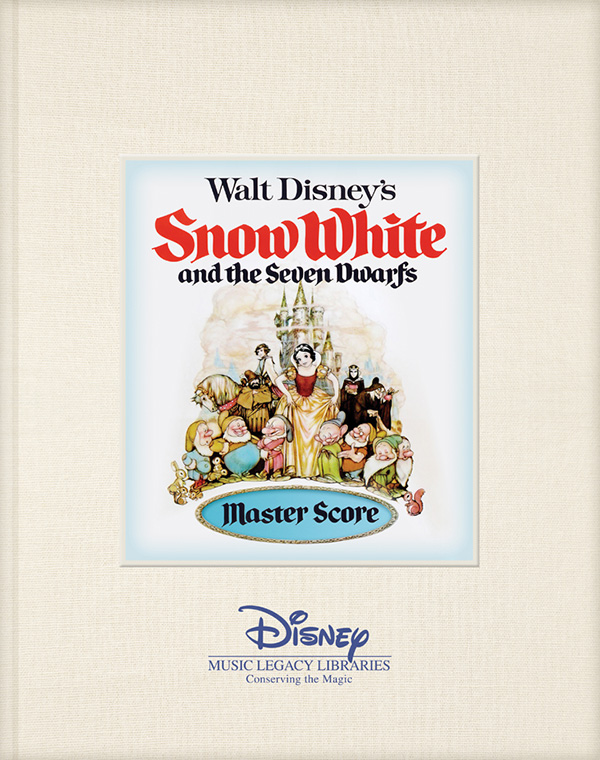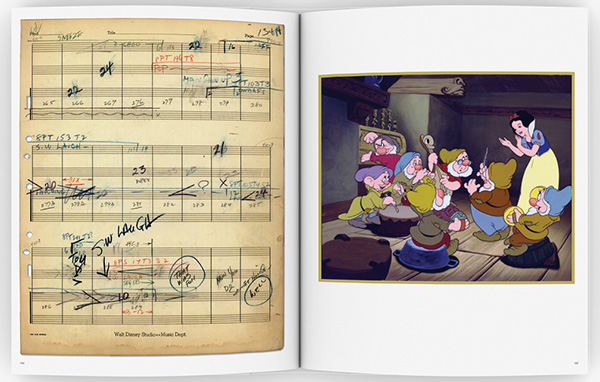

  |
|
|
||||||||||||||||||||||
|
FMS FEATURE... August 12, 2015 Disney's Snow White Score Published Lavish book highlights studio's music preservation efforts by Jon Burlingame  Snow White and the Seven Dwarfs Master Score has just been released in what publisher Hal Leonard calls a "one-of-a-kind, hand numbered, limited edition" of 400. (At $300, it will appeal mostly to collectors, educators and Disney enthusiasts.) But it is so unusual for a studio to release an actual musical score – especially one of major historical value – that it's worth more than a casual look. The 200-page "master score," according to the book's preface, "guided the construction of the film's final mix" of music, dialogue and sound effects. Not just notes on staffs, it also contains notes on the action, what's being said, what else we are hearing... in effect, the film's entire soundtrack in written form. It's a fascinating document and wonderfully illustrated with images from Walt Disney's 1937 classic, which was the first full-length animated feature film. Unlike other studios, many of which have not understood the value of their music (and in some cases, such as MGM's notorious 1970 trashing of its music library, have actively worked to destroy it), Disney has always saved its written and recorded music assets. Over 87 years, dating back to the earliest Mickey Mouse shorts and Silly Symphonies, millions of pages of music have been written, orchestrated and copied into parts for individual musicians. Jon Heely, now director of music publishing and concert licensing for Disney, was an arranger and copyist back in 1983 when he first organized the studio's yellowing musical scores. It was in the basement of the Ink and Paint building on the Burbank lot, he remembers. He and fellow copyist Marshall Bowen put everything into acid-free folders and boxes, effectively beginning the conservation process that continues to this day. "There was a tradition of music being important," Heely says. "They're now stored away in climate controlled conditions." Equally important, there is a consistent need for these classic scores, as they are often used in theme-park attractions or referenced in remakes or sequel films (the recent Cinderella film used "A Dream Is a Wish Your Heart Makes," and a new Jungle Book is now in production, for example). Over the past several years, the Disney Channel's Have a Laugh! series has condensed more than 50 classic cartoons down to three minutes each, which required them to be rescored using the original 1930s, '40s and '50s scores (which composer-conductor Mark Watters arranged and re-recorded). It would not have been possible if Disney hadn't held onto all those scores. It was the job of Reggie Wilson, then vice president for music production, to track down those scores as well as the contracts for the composers and music publishers (the paperwork aspect that Gena Downey, director of music research and administration, calls "music forensics"). It was Wilson who spearheaded a move to locate and start scanning all of Disney's music documents and scores.  A first phase involved finding and scanning contracts and music-related documents, such as musician rosters; a second phase was the gigantic task of scanning all of the lead sheets, orchestral scores and parts. "The Animation Research Library and the Disney Archives adopted us," Downey says. "Over a million documents, and just under a million in our administrative files" have now been scanned, she reports, trimming back the time necessary to find anything "from two weeks to three minutes. We had to conserve the music and streamline our research process." The project is now called Disney Music Legacy Libraries, which the studio defines as "a comprehensive and elegant resource solution for documenting and retrieving all phases of the music scoring, contracting and recording process... [to] allow efficient administrative and legal production choices, provide rapid and convenient research of historic and modern music, and enable creative repurposing of Disney's greatest music-related assets." The Snow White book is the first commercial spinoff of this corporate initiative. Keith Mardak, chairman and CEO of Hal Leonard, the world's largest music print publishing company, sees the preservation aspect of this project as critical. "This stuff is handwritten. That's quite unique," he points out. Disney insiders hint that if Snow White sells out, other similar volumes (perhaps covering classics like Pinocchio, Bambi and Dumbo) could follow. The Snow White book is expected to be available at this weekend's D23 event in Anaheim, Calif. More information about the book is available at the Disney Music Emporium. ©2015 Jon Burlingame |
Search
Past Features
Feature Archives
|